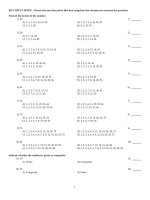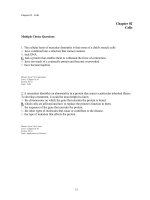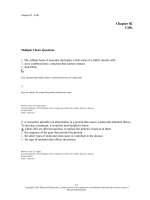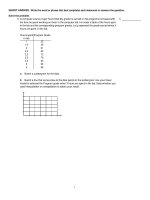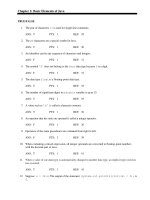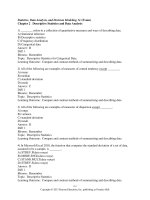Lecture Contemporary strategy analysis: Concepts, techniques, applications (5th edition): Chapter 3 - Robert M. Grant
Bạn đang xem bản rút gọn của tài liệu. Xem và tải ngay bản đầy đủ của tài liệu tại đây (206.13 KB, 10 trang )
<span class='text_page_counter'>(1)</span><div class='page_container' data-page=1>
<b>Industry Analysis: The Fundamentals</b>
<b>Industry Analysis: The Fundamentals</b>
•
<b>The objectives of industry analysis</b>
•
<b>From environmental analysis to industry analysis</b>
•
<b>Porter’s Five Forces Framework</b>
•
<b>Applying industry analysis</b>
•
<b>Industry & market boundaries</b>
•
<b><sub>Identifying Key Success Factors</sub></b>
</div>
<span class='text_page_counter'>(2)</span><div class='page_container' data-page=2>
<b>The Objectives of Industry </b>
<b>Analysis</b>
<b>The Objectives of Industry </b>
<b>Analysis</b>
•
<b>To understand how industry structure drives competition, </b>
<b>which determines the level of industry profitability.</b>
•
<b>To assess industry attractiveness</b>
•
<b>To use evidence on changes in industry structure to </b>
<b>forecast future profitability</b>
•
<b>To formulate strategies to change industry structure to </b>
<b>improve industry profitability</b>
</div>
<span class='text_page_counter'>(3)</span><div class='page_container' data-page=3>
<b>THE INDUSTRY</b>
<b>ENVIRONMENT</b>
•
<b> Suppliers</b>
•
<b> Competitors</b>
•
<b> Customers</b>
<b>Social structure</b>
<b>The national/ </b>
<b>The national/ </b>
<b>international </b>
<b>international </b>
<b>economy</b>
<b>economy</b>
<b>Technology</b>
<b>Technology</b>
<b>Government</b>
<b>Government</b>
<b>& Politics</b>
<b>& Politics</b>
<b>The natural </b>
<b>The natural </b>
<b>environment</b>
<b>environment</b>
<b>Demographic </b>
<b>Demographic </b>
<b>structure</b>
<b>structure</b>
<b>Social structure</b>
<b>Social structure</b>
<b>From Environmental Analysis </b>
<b>to Industry Analysis</b>
<b>From Environmental Analysis </b>
<b>to Industry Analysis</b>
•
<i><b>The Industry Environment lies at the core of the Macro Environment. </b></i>
</div>
<span class='text_page_counter'>(4)</span><div class='page_container' data-page=4>
<b>Profitability of US Industries</b>
<b>Profitability of US Industries</b>
<b>Pharmaceuticals </b> <b>26.8</b> <b>Gas & Electric Utilities </b> <b> 10.5</b>
<b>Tobacco</b> <b>22.0 </b> <b>Food and Drug Stores </b> <b> 10.3</b>
<b>Household & Personal Products </b> <b>20.5 </b> <b>Motor Vehicles & Parts </b> <b> 9.8</b>
<b>Food Consumer Products</b> <b>20.3</b> <b>Home Equipment</b> <b> 9.5</b>
<b>Medical Products & Equipment </b> <b>18.8</b> <b>Railroads</b> <b> 9.0</b>
<b>Beverages</b> <b>18.8 </b> <b>Hotels, Casinos, Resorts</b> <b> 8.0</b>
<b>Scientific & Photographic Equipt.</b> <b>16.5</b> <b>Insurance: Life and Health 7.6</b>
<b>Commercial Banks</b> <b>16.0 </b> <b>Building Materials, Glass</b> <b> 7.0</b>
<b>Publishing, Printing </b> <b>14.3 </b> <b>Metals </b> <b> 6.0</b>
<b>Petroleum Refining</b> <b>14.3 </b> <b>Semiconductors &</b>
<b>Apparel </b> <b>14. 3 </b> <b> Electronic Components</b> <b> 5.8</b>
<b>Computer Software </b> <b>13.5 </b> <b>Insurance: Property & Casualty 5.3</b>
<b>Electronics, Electrical Equipment </b> <b>13.3 </b> <b>Food Production</b> <b> 5.3</b>
<b>Furniture</b> <b>13.3</b> <b>Telecommunications</b> <b> 3.5</b>
<b>Chemicals</b> <b>12.8</b> <b>Forest and Paper Products 3.5</b>
<b>Computers, Office Equipment</b> <b>11.8 </b> <b>Communications Equipment (4.0)</b>
<b>Health Care</b> <b>11.5 </b> <b>Airlines</b> <b> (34.8)</b>
</div>
<span class='text_page_counter'>(5)</span><div class='page_container' data-page=5>
<b>Long-term Profitability of US Industries: EVA and ROA, 1986-97</b>
<i><b>Industry </b></i> <i><b>EVA/CE ROA</b></i> <i><b> Industry</b></i> <i><b>EVA/CE ROA</b></i>
<b>Tobacco </b> <b> 9.4</b> <b> 14.4</b> <b> Paper and products</b> <b> (1.5) 5.2</b>
<b>Computer software </b> <b> Broadcasting and </b>
<b>& services </b> <b> 5.9 </b> <b> 10.4 </b> <b> publishing</b> <b> (1.5) 6.0</b>
<b>Personal care </b> <b> Cars & trucks</b> <b> (1.5)</b> <b> 2.2 </b>
<b>products</b> <b> 2.8 </b> <b> 8.0 </b> <b> Healthcare services</b> <b> (1.7) </b> <b> 3.3 </b>
<b>Medical products 2.7</b> <b> 9.5 </b> <b> Machine tools, hand tools (1.7)</b> <b> 6.0 </b>
<b>Printing & </b> <b> Appliances and home </b>
<b>advertising </b> <b> (2.0) </b> <b> 2.3 </b> <b> furnishings </b> <b> (1.9) 3.4</b>
<b>Food processing 2.5 </b> <b> 8.5 Telephone equipment & </b>
<b>Drugs & research 0.7 </b> <b> 7.6 </b> <b> services (2.1) 7.0</b>
<b>Beverages</b> <b> 0.2 </b> <b> 5.6 </b> <b> Plastics & products</b> <b> (2.6) 5.3</b>
<b>Textiles </b> <b> (0.1) </b> <b> 7.4 </b> <b> Computers & peripherals (3.1) 3.1</b>
<b>Fashion retailing (0.4) </b> <b> 9.3 </b> <b> Electrical products </b> <b> (3.3) 4.6</b>
<b>Building materials (0.6) </b> <b> 5.6 </b> <b> Aerospace & defense </b> <b> (3.3) 4.8</b>
<b>Metals </b> <b> (1.0) </b> <b> - </b> <b> Railroads </b> <b> (3.4) 3.8</b>
<b>Telecom services (1.2) </b> <b> 4.6 </b> <b> Airlines (4.1) 1.0</b>
<b>Discount retailing (1.2) </b> <b> 6.4 </b> <b> Steel </b> <b> (6.4) 2.3 </b>
<b>Semiconductors </b> <b> Cable television </b> <b> (7.2) (3.3)</b>
<b>& components</b> <b> (1.3) </b> <b> 6.0 </b> <b> Electronics </b> <b> (9.2) 3.5</b>
<b> </b><i><b>Average </b></i> <i><b> (1.1) 5.6</b></i>
</div>
<span class='text_page_counter'>(6)</span><div class='page_container' data-page=6>
<b>The Determinants of Industry </b>
<b>Profitability</b>
<b>The Determinants of Industry </b>
<b>Profitability</b>
<i><b>3 key influences</b></i>
<b>:</b>
•
<b>The value of the product to customers</b>
•
<b>The intensity of competition</b>
</div>
<span class='text_page_counter'>(7)</span><div class='page_container' data-page=7>
<b>The Spectrum of Industry Structures</b>
<b>The Spectrum of Industry Structures</b>
<i>Concentration</i>
<i>Entry and Exit</i>
<i>Barriers</i>
<i>Product</i>
<i>Differentiation</i>
<i>Information</i>
<i><b>Perfect </b></i>
<i><b>Competition</b></i>
<i><b>Oligopoly</b></i>
<i><b>Duopoly</b></i>
<i><b>Monopoly</b></i>
Many firms
A few firms
Two firms
One firm
No barriers
Significant barriers
High barriers
Homogeneous
Product
Potential for product differentiation
Perfect
</div>
<span class='text_page_counter'>(8)</span><div class='page_container' data-page=8>
<b>Porter’s Five Forces of </b>
<b>Competition Framework</b>
<b>Porter’s Five Forces of </b>
<b>Competition Framework</b>
<b>SUPPLIERS</b>
<b>POTENTIAL</b>
<b>ENTRANTS</b>
<b>SUBSTITUTES</b>
<b>BUYERS</b>
<b>INDUSTRY</b>
<b>COMPETITORS</b>
<b>Rivalry among</b>
<b>existing firms</b>
<b>Bargaining power of suppliers</b>
<b>Bargaining power of buyers</b>
<b>Threat of</b>
<b>new </b>
<b>entrants</b>
</div>
<span class='text_page_counter'>(9)</span><div class='page_container' data-page=9>
<b>THREAT OF ENTRY</b>
•<b>Capital requirements</b>
•<b>Economies of scale</b>
•<b>Absolute cost advantage</b>
•<b>Product differentiation</b>
•<b>Access to distribution</b>
<b> channels</b>
•<b>Legal/ regulatory barriers</b>
•<b>Retaliation</b>
<b>SUBSTITUTE</b>
<b>COMPETITION</b>
•<b> Buyers’ propensity</b>
<b> to substitute</b>
•<b> Relative prices & </b>
<b> performance of</b>
<b> substitutes</b>
<b>BUYER POWER</b>
•<b><sub> Buyers’ price sensitivity </sub></b>
•<b> Relative bargaining</b>
<b> power</b>
<b>INDUSTRY RIVALRY</b>
•<b>Concentration</b>
•<b>Diversity of</b>
<b> competitors</b>
•<b>Product differentiation</b>
•<b>Excess capacity &</b>
<b> exit barriers</b>
•<b>Cost conditions</b>
<b>BUYER POWER</b>
•<b><sub> Buyers’ price sensitivity </sub></b>
•<b> Relative bargaining</b>
<b> power </b>
</div>
<span class='text_page_counter'>(10)</span><div class='page_container' data-page=10>
<b>Threat of Substitutes</b>
<b>Threat of Substitutes</b>
<i><b>Extent of competitive pressure from producers of</b></i>
<i><b>substitutes depends upon</b></i>
<b>:</b>
•
<b>Buyers’ propensity to substitute</b>
</div>
<!--links-->

